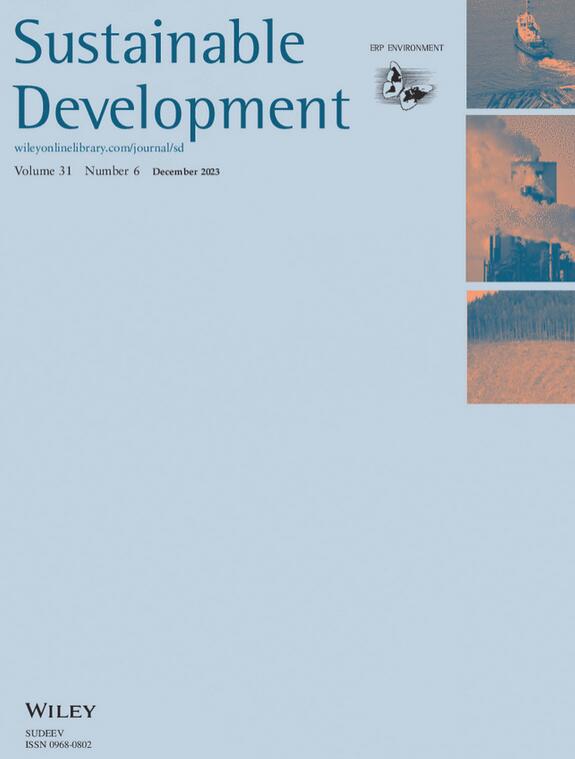清洁能源和绿色创新对实现g20环境可持续性的动态影响评估
IF 8.2
1区 环境科学与生态学
Q1 DEVELOPMENT STUDIES
引用次数: 0
摘要
在经济增长和发展的背景下,环境质量的稳定性一直是可持续发展的挑战,气候条件、人为全球变暖、森林砍伐、水和空气质量恶化等环境问题呈上升趋势。在当代物质主义范式下,在保证自然资源可持续消耗的同时实现高经济增长率是不可能的。世界需要达到一种经济增长率,这种增长率确认了自然资源消费和资源开发的可持续性,这使人们对这种轨迹进展的可持续性产生了严重的警惕,因为经济增长的增加会使自然储备的使用和能源需求激增,从而导致环境的剥夺。理论和实证文献都支持绿色或清洁能源可以显著地维持环境质量和促进经济增长。最近的文献评估了绿色技术在促进环境可持续性方面的作用。它强调绿色创新是最有效的方法,可以有效地利用资源,从而减少环境退化。因此,本研究的主要目的是分析1992年至2018年期间经济增长、清洁能源、技术创新、自然资源枯竭以及绿色和可持续技术对g20国家环境退化的影响。横断面-自回归-分布滞后(CS - ARDL)模型估计的结果表明,g20国家的经济增长、专利申请量、环境相关技术的发展占所有技术的百分比、自然资源租金(NRR)占GDP的百分比、可再生能源消费、贸易开放程度和环境退化之间存在长期关联。本研究在选定的国家中重新证实了环境库兹涅茨曲线(EKC)假设。此外,研究结果表明,清洁能源和技术创新,主要是绿色技术,在维持这些选定国家的环境条件方面发挥了重要作用。此外,自然资源的枯竭程度直接影响到选定国家的环境退化(CO₂排放量、温室气体排放总量和生态足迹)。该研究强调了促进清洁能源、绿色技术和可持续实践以平衡经济增长和环境保护的重要性,并为g20国家的决策者提供了有价值的政策建议。本文章由计算机程序翻译,如有差异,请以英文原文为准。
The dynamic impact assessment of clean energy and green innovation in realizing environmental sustainability of G‐20
Abstract In the context of the growth and development process, stability in environmental quality has remained a challenging issue to sustainable development, as several environmental problems, such as climate conditions, anthropogenic global warming, deforestation, and escalating degradation of water and air quality, depict a rising trend. In the contemporary materialistic paradigm, attaining a high economic growth rate while ensuring sustainable consumption of natural resources is impossible. The world needs to attain an economic growth rate that confirms sustainability in natural resource consumption and exploitation of resources introduced severe alert about the sustainability of such trajectory progress as an increase in economic growth upsurges natural reserve usage and energy demand, which leads to environmental deprivation. Both theoretical and empirical literature support that green or clean energy sources could significantly sustain environmental quality and foster economic growth. The recent literature assessed the role of green technology in promoting environmental sustainability. It emphasizes that green innovations are the most competent method to carry the competent use of resources, thereby reducing environmental degradation. Therefore, the main aim of this study is to analyze the impact of economic growth, clean energy, technological innovations, natural resources depletion, and green and sustainable technology on the environmental degradation of G‐20 nations in the frame spanning from 1992 to 2018. The results of cross‐sectional‐autoregressive‐distributed lag (CS‐ARDL) model estimation indicate the presence of a long‐run association between economic growth, number of filled applications for patents, development of environment‐related technologies as a percentage of all technologies, natural resources rents (NRR) as a percentage of GDP, renewable energy consumption, trade openness and environment degradation of G‐20 nations. This study re‐confirmed the Environmental Kuznets Curve (EKC) hypothesis for selected nations. Further, the study's findings revealed that cleaner energy and technological innovations, mainly green technology, play a significant role in sustaining the environmental conditions of these selected countries. Moreover, the degree of natural resource depletion directly impacts environmental degradation (CO₂ emission, total greenhouse gases emission and ecological footprints) in selected nations. The study underscores the importance of promoting clean energy, green technology, and sustainable practices to balance economic growth and environmental preservation and provides policymakers in G‐20 nations with valuable policy recommendations.
求助全文
通过发布文献求助,成功后即可免费获取论文全文。
去求助
来源期刊

Sustainable Development
Multiple-
CiteScore
17.30
自引率
11.20%
发文量
168
期刊介绍:
Sustainable Development is a publication that takes an interdisciplinary approach to explore and propose strategies for achieving sustainable development. Our aim is to discuss and address the challenges associated with sustainable development and the Sustainable Development Goals. All submissions are subjected to a thorough review process to ensure that our readers receive valuable and original content of the highest caliber.
 求助内容:
求助内容: 应助结果提醒方式:
应助结果提醒方式:


